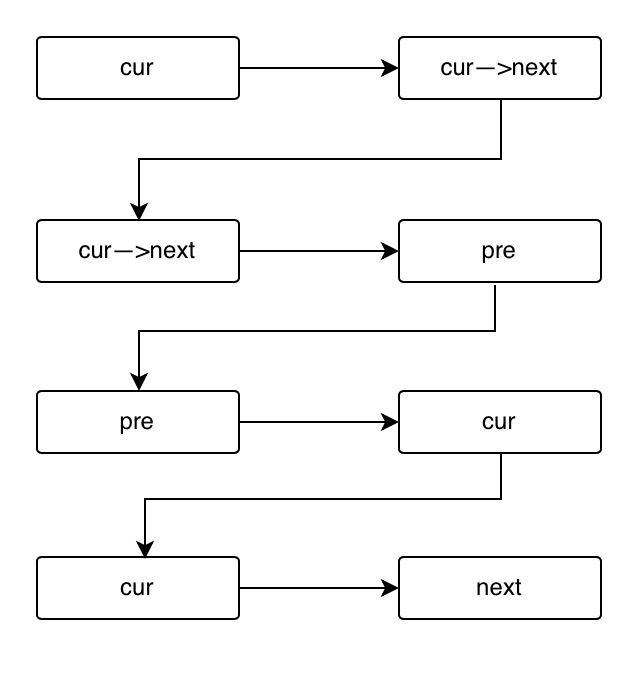从尾到头打印链表
输入一个链表,按链表从尾到头的顺序返回一个ArrayList。
示例
输入
{67, 0, 24, 58}
返回值
[58, 0, 24, 58]
方法一
直接用简单粗暴的std::reverse()方法直接将List颠倒。
vector<int> printListFromTailToHead(ListNode* head){
vector<int> res;
while(head){
res.push_back(head->val);
head = head->next;
}
std::reverse(res.begin(), res.end());
return res;
}
方法二
相对于一个数组取反过程,可以考虑使用入栈和出栈操作来实现,顺序读取链表元素存入栈,再将元素出栈存入数组中可以得到一个相反的ArryList,代码如下:
class Solution{
public:
vector<int> printListFromTailToHead(ListNode* head){
stack<int> s;
vector<int> res;
while(head){
s.push(head->val); //将元素入栈
head = head->next;
}
while(!a.empty()){
res.push_back(s.top); //读取栈顶元素存入vector
s.pop(); //弹出栈顶元素
}
}
};
方法三
考虑到可以使用反转链表的操作来实现。反转链表的精髓是定义三个指针head,pre,next。首先准备一个pre结点初始指向nullptr,表示正在反转结点的前一个结点,再准备一个cur,表示当前正在反转的结点,cur初始化为head。最后在准备一个next,表示还未反转的下一个结点。
使用如下示意图方便记忆,其中箭头表示等于:

代码如下:
/**
* struct ListNode {
* int val;
* struct ListNode *next;
* ListNode(int x) :
* val(x), next(NULL) {
* }
* };
*/
class Solution {
public:
vector<int> printListFromTailToHead(ListNode* head) {
ListNode* pre = nullptr;
ListNode* cur = head;
ListNode* next=cur;
while(cur){
next = cur->next;
cur->next = pre;
pre = cur;
cur = next;
}
vector<int> st;
while(pre){
st.push_back(pre->val);
pre = pre->next;
}
return st;
}
};





















 919
919

 被折叠的 条评论
为什么被折叠?
被折叠的 条评论
为什么被折叠?








